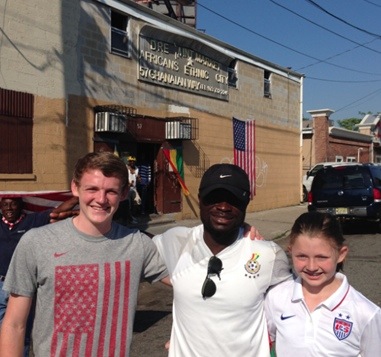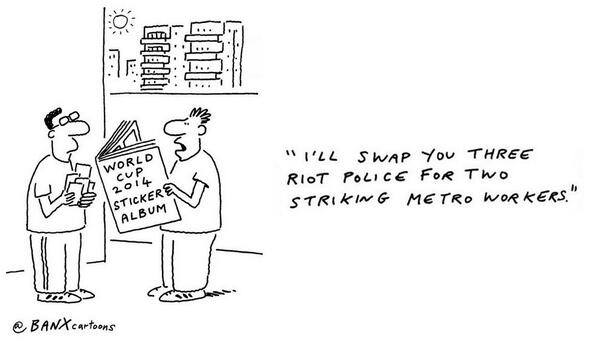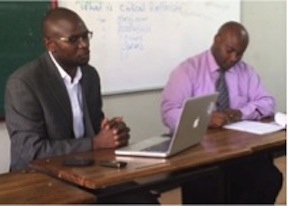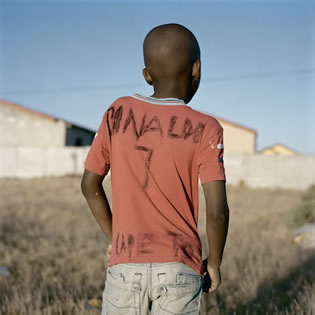
June 17, 2014
By Tom McCabe*
The text message came through as “URGENT.” Sylvers Owusu, a former student and player, wrote yesterday: “We just received a city permit to block off Ghanaian Way in Newark for today’s GHA vs. USA match. Please join us for a watch party! DJ Albert will provide music to entertain the crowd. Let’s go Ghana!”
The plan was now hatched: first half in Newark, and the second half a few miles away in what has been called “the cradle of American soccer.” I watched several games at the Scots American Club in Kearny in 2010, including the Algeria match punctuated by Donovan’s last-ditch winner. (I also watched Ghana knock the USA out there).
Back at the Scots Club there was a much more joyous celebration to Dempsey’s early strike [click here for video.]
Ten minutes later the Ghanaian congregation began singing a song, unrecognizable to my ears. Sylvers whispered to me: “It’s a gospel song. We need God now.” Ghana grabbed control of the game, but the USA threatened on several occasions to double the lead. It was an intense, physical start to a must-win match.
At the half-time whistle we headed outside and took in the street scenes. DJ Albert had the place jumping and after some dancing and chanting we got back into the car and headed for the Passaic River. Kearny, home to American stars (John Harkes, Tab Ramos, and Tony Meola), the Scots Club, and the second half beckoned.
We arrived ten minutes into the second half as parking was scarce around the Scots Club, but the USA still had that slim one-goal lead. The bar-end of the social club formed in 1932 was packed with people in red, white and blue. “USA” chants rang out as well as repeated frustration about how the Stars and Stripes couldn’t hold on to possession.
After Ghana leveled the score in the 82nd minute it seemed that they would go on to find the winner, but against the flow of the second half John Brooks powered home a precisely-placed Graham Zusi corner. Understandably, there was bedlam inside the Scots Club once again. Hugs, high-fives, chants, and more hugs. It was a major victory in “The Group of Death” that sets up an epic battle against Portugal on Sunday.
*Tom McCabe is an historian at Rutgers University-Newark where he teaches surveys in U.S. History, History of Newark, and History of Soccer. Follow him on Twitter at @tommccabe5. This post was originally published on his new blog Soccer Brains.
Brazil 2014: World Cup Politics
The day before the magic kingdom opens in São Paulo, WKAR’s “Current State” host Mark Bashore interviewed me about the politics of the World Cup. We discussed FIFA profits and institutional reform, special World Cup laws and extraterritoriality, nation-building, development, civic protests, and what the future holds for Brazil, on and off the pitch. Originally broadcast live on June 11, 2014. Take a listen!

World Cup Music: “Afri Can”
An antidote to Shakira and Pitbull!
“Afri Can” is a charity single by Replay GH, a Ghana-based group featuring Zed Ay Kay (Replay GH), Fuji, Farid, and Gustav. It brings together influence from the five African countries that have qualified for the Brazil 2014 World Cup: Ghana, Nigeria, Cameroon, Algeria, and Ivory Coast.
According to the artists, “the different influences, and styles are seamlessly woven together to produce a modern Afro Beats song for the enjoyment of all football and music fans.” To find out more about Afri Can, visit: http://www.outofafricacampaign.com/afri-can/
Zambian Fútbology
 Guest Post by *Hikabwa Chipande
Guest Post by *Hikabwa Chipande
LUSAKA—On June 4, 2014, I was invited by Dr. Walima Kalusa, the University of Zambia’s History Department head, to present a fútbological paper based on my current doctoral research on the political and social history of football in Zambia (1940s-1993). The seminar on “Football and Social Change on the Northern Rhodesian Copperbelt, 1940s to 1960s” was well attended by UNZA History staff, graduate students, and other interested scholars.
I explored how urbanized African miners appropriated football from their European supervisors and, after World War II, created a new black popular culture. When colonial authorities and mining companies introduced post-War social welfare programs to appease miners and urban residents, local Africans used these structures to demand greater access to resources for organized football and other amenities in their communities. In the late 1940s and into the 1950s, Africans popularized the game on the Copperbelt and used it to build vibrant social networks and communities to replace what they left in their rural villages.
As early as 1937, the British had established the Central Native Committee, which seized control of African sport due to fears that the colonized might use football as a tool for political agitation. Despite these moves, ordinary African athletes, officials, and fans developed alternative ways of organizing and enjoying their football. For example, supporters clubs formed. These hard-core fans unexpectedly made club officials and mine managers more accountable to the people. The emerging vernacular fan culture, which no scholar has ever researched before, shows how Zambians were sometimes able to use sport to rework the application of harsh colonial policies.
Another aspect of the history of Zambian football that has eluded researchers has to do with international matches played in colonial times. As I have discovered, Copperbelt teams played in the Belgian Congo, Southern Rhodesia (Zimbabwe), and South Africa. My work illustrates how these sporting adventures, among other things, turned into incubators for Pan-Africanism because the camaraderie experienced by Zambians in these contests sharpened their sense of solidarity with fellow Africans in neighboring colonies.
 Alexandra Wrage, a Canadian attorney and founder of TRACE International, a business anti-corruption group, was interviewed by BBC Newsnight about the ongoing FIFA corruption scandal over Qatar’s successful bid to host the 2022 World Cup.
Alexandra Wrage, a Canadian attorney and founder of TRACE International, a business anti-corruption group, was interviewed by BBC Newsnight about the ongoing FIFA corruption scandal over Qatar’s successful bid to host the 2022 World Cup.
Wrage worked for FIFA’s governance reform commission from 2011 to 2013. In April 2013 she told the Wall Street Journal “that the FIFA executive committee ‘undermined the recommendations we were making’at almost every turn.” She resigned because “you don’t keep doing the same thing if you’re not having an impact.”
Wrage believes change is more likely to come if Swiss law regulates locally based non-profits like FIFA (sic!) more effectively and, perhaps, if a groundswell of popular criticism can compel corporate sponsors to take action.
Click here to watch the 4-minute interview.
How Africa Developed Europe

African national teams in the 2014 World Cup will rely overwhelmingly on Europe-based players. Here are the exact numbers according to the preliminary lists recently released by FIFA:
Cameroon: 26 out of 28
Ivory Coast: 26 out of 28
Nigeria: 25 out of 30
Ghana: 25 out of 26
Algeria: 25 out of 30
The data reveal that nearly nine out of ten Africans likely to be in Brazil next month play for European clubs. 127 out of 142 players, or 89.4 percent, to be exact. Just over half (52.1 percent) of these players come from Big 5 leagues (England, Spain, Italy, Germany, Spain).
Four years ago, the percentage of Europe-based players in the final 23-man squads of the six African nations was around 80 percent (click here for data). This lower figure stemmed largely from South Africa’s use of players from its domestic Premier Soccer League, ranked among the Top 10 richest leagues in the world.
The 2014 numbers also reveal that nine of the fifteen Africa-based players on the preliminary lists are goalkeepers. In other words, a minuscule 0.42 percent of “outfield” players are on the books of African clubs.
The export of talent from Africa to Europe, as the academic research demonstrates, has produced winners and losers. In strictly economic terms, benefits accrue to individual players who make it into European football, as well as to African coaches, scouts, and other local stakeholders in this global commodity chain. But in the end the lion’s share of the financial rewards in this relationship go to European clubs and leagues, usually at the expense of the sustainability and quality of domestic leagues and clubs in Africa.
***
Addendum (4pm ET, May 23, 2014)
In response to @TonyKaron’s comment on Facebook about the similarities of Africa with Latin America, here are the numbers for foreign-based players on South American team lists:
Brazil: 19/23 (18 Europe, 1 Canada)
Chile: 19/26 (15 in Europe, 3 Brazil, 1 Mexico)
Colombia: 24/27 (18 Europe, 2 Mexico, 3 Argentina, 1 Brazil)
Uruguay: 24/25 (16 Europe, 1 Japan, 4 Brazil, 1 Argentina, 1 Paraguay, 1 Mexico)
Ecuador: 17/30 (5 Europe, 7 Mexico, 1 Colombia, 1 Brazil, 1 USA, 1 Saudi Arabia, 1 UAE)
Argentina: 22/26 (20 Europe, 1 Brazil, 1 Mexico)
Total: 125/157 (79.6 percent)
I also ran the Asia numbers:
Australia: 22/30 (17 Europe, 1 USA, 1 Japan, 1 S. Korea, 1 China, 1 Qatar)
Japan: 12/23 (all in Europe)
Iran: 10/30 (7 Europe, 1 Qatar, 1 Canada, 1 Kuwait)
South Korea: 17/23 (9 Europe, 4 Japan, 3 China, 1 Saudi Arabia)
Total: 61/106 (57.5 percent)
I was recently interviewed by BBC Brasil‘s João Fellet and asked to compare the hosting of the 2010 World Cup in South Africa with the preparations for the 2014 World Cup in Brazil. Below is the Portuguese text of what transpired [translate] and a link to read the full article.
15 May 2014
BBC Brasil – Quatro anos depois da Copa de 2010, o que ficou do torneio para os sul-africanos?
Peter Alegi – Há um tipo de nostalgia por aquele período, por aquela sensação de unidade, solidariedade, de estar no centro do mundo. Os estrangeiros que foram para a Copa perceberam que os estereótipos negativos sobre a África do Sul não eram verdadeiros, e isso ainda faz o país se sentir bem. As emoções de um carnaval como a Copa são difíceis de bater.
BBC Brasil – Houve outros legados?
Alegi – O legado emocional foi importante de diferentes maneiras. Ele fez as pessoas sentirem um senso de unidade num país ainda muito dividido quanto a raças, classes e gêneros. Nos estádios sul-africanos, as pessoas cantam o hino abraçadas ou de mãos dadas, como nas igrejas. Num país onde o povo não tem muitas oportunidades de estar junto, a mágica do nacionalismo explodiu de uma maneira positiva.
Isso aconteceu só 16 anos após o apartheid. Sediar um evento bem sucedido fez com que os sul-africanos se sentissem muito orgulhosos.
O torneio também despertou sentimentos de panafricanismo. Por um ou dois meses, os sul-africanos se sentiram parte do continente africano. Isso foi encorajador, levando em conta os problemas do país com a xenofobia.

To read full article click here.